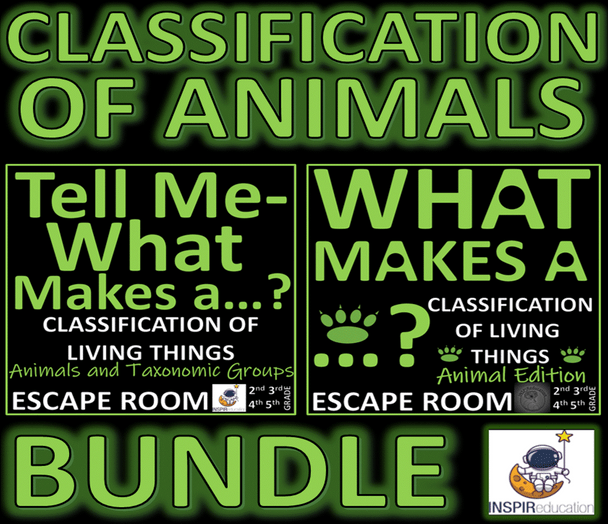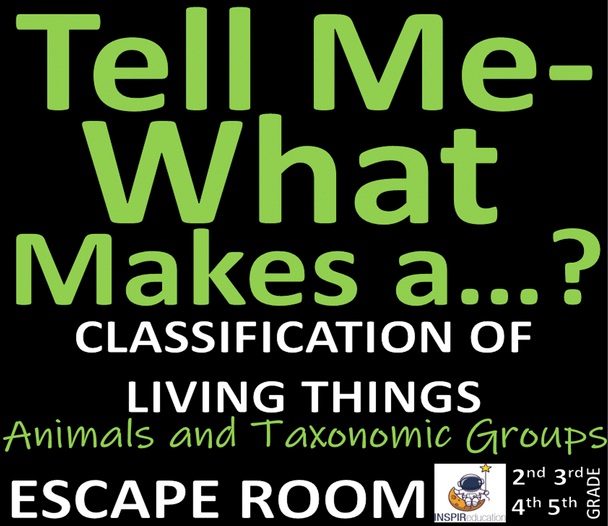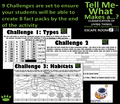Description
In learning about the Classification of Animals, we have produced two Escape Rooms which compliment one another in their styles and ways of investigating classification and taxonomy of animals (including 8 key groups: mammals, insects, birds, fish, crustaceans, amphibians, arachnids and reptiles). Using an Escape Room to develop curriculum knowledge is an exciting activity that will inspire learners from 2nd Grade to 5th Grade.
The curriculum content of these Escape Rooms are linked to:
- Characteristics of Living Things (Animals)
The aim of these Escape Rooms is to provide jeopardy for the students to work under pressure to solve 19 challenges in all to help scientists who have forgotten how to classify animals using a wide range of characteristics based on the features of all living things (appearance, movement, respiration, reproduction and life cycles etc).
ESCAPE ROOM 1: Tell me - What makes an...
This Escape Room takes students through a guided review of animals and their features within their taxonomic groups. It includes all you need to successfully run and Escape Room.
Before beginning, you will need to prepare the following:
- A copy of the Pupil Workbook for each group
- Team label names printed (if required)
- Teacher answer booklet printed for assessment
- IT sources and research materials (if this is an introduction to the topic of characteristics of animals)
- Initial Starting Script sharing the problem to the children
- Completion Script celebrating the completion of the challenge
Children do not need prior knowledge of the topic above to complete this Escape Room, as the research will support the answers and each Challenge is supported with clues and given answers to sort and sequence. This Escape Room is ideal as a review of learning.
The activity begins by the teacher reading the Initial Message received. It clearly tells the children that they are required to help scientists to classify animals – as for some reason, all scientists have lost the ability and memory to sort animals and place them into their taxonomic groups! The only way they can do this is to solve the 9 challenges which will lead the students to creating 8 fact files for each of the taxonomic groups featured (mammals, insects, birds, fish, arachnids, crustaceans, amphibians and reptiles). The templates for the fact files are included in the Code Key Booklet for teams to use.
What follows are 9 challenges which the children must solve to discover the code to move onto the next activity.
Each activity focuses and builds the students’ knowledge on many aspects of classification of animals.
The 9 activities are based on the following outcomes:
- Using a code breaking activity to identify the 8 taxonomic groups which will be studied within this activity: (mammals, insects, birds, fish, arachnids, crustaceans, amphibians and reptiles).
- Using the names of the animal groups to identify a hidden word (habitats)
- Learn about and match animal groups to their preferred habitats
- Matching physical features of the each of the groups
- Identification of movement – how each of the animals move on land, in water, in the air, or more than one using a Venn diagram for sorting
- Completing Food Chains by adding the taxonomic group which would eat the given food chain
- Sequencing and completing 8 Life Cycles for each of the groups
- Know how each of the animals breathe (lungs, gills or trachea) and to know whether they are warm or cold-blooded
- Finally, use all the identified information to complete 8 fact files – templates to identify the features included in the Code Key Booklet.
When all 9 activities are completed and the fact files finished, the teacher can read the final communication detailing how the children have been able to help the scientists to continue their important work.
Setting up the Escape Room
1. Children should be split into groups of no more than four and be placed in their own work space.
2. Access to IT and research materials can be provided to allow students to research answers to questions and review their own knowledge, as well as checking answers.
3. Each group should have a Code Key Booklet and decide on a team name
4. Read the Initial Message to the children to set the challenge in context. Discuss what this means, and what the activity entails.
5. Agree with the students a set time to complete the problems in – this ensures that the students stay on task and maintains the Escape Room element of working under pressure. Begin with Challenge 1.
6. At the end of the time, students should have filled in the Code Key in their booklet. The teacher can then check the accuracy of all the groups and talk through the responses the children should have.
7. Move on through the remaining challenges until all 9 have been completed.
8. For those groups who have been successful, they are then able to read the completed statement where they find out if they have escaped the Escape Room and saved the Earth!
There are other ways of running Escape Room activities, for example, each activity could be set up on 10 tables and the children then move from table to table completing the activity. This would reduce the need for as many resources, and access to non-fiction sources and Internet Resources could then be targeted at specific Challenges.
The Escape Room should last for 2 hours.
ESCAPE ROOM 2: What makes a ... a...?
Children do not need prior knowledge of the topic above to complete this Escape Room, as the research will support the answers and each Code Key is supported with several clues. This Escape Room is ideal as a review of learning.
The activity begins by the teacher reader the Initial Message received. It clearly tells the children that they are required to help scientists to classify animals – as for some reason, all scientists have lost the ability and memory to sort animals and place them into their taxonomic groups! The only way they can do this is to solve the 10 challenges within this Escape Room. Failure is not an option!
What follows are 10 challenges which the children must solve to discover the code to move onto the next activity.
Each activity focuses and builds the children’s knowledge on many aspects of classification of animals.
The 10 activities are based on the following outcomes:
- Know the 7 main features of all living things
- Understand that animals can be grouped into taxonomic groups (arachnid, bird, amphibian, insect, mammal, crustacean, fish and reptiles). The activity can be extended to included other animal groups should the teacher wish to develop it further to add other animal groups)
- What makes an insect an insect?
- What makes an arachnid an arachnid?
- What makes a fish a fish?
- What makes an amphibian an amphibian?
- What makes a bird a bird?
- What makes a reptile a reptile?
- What makes a crustacean a crustacean?
- What makes a mammal a mammal?
When all 10 activities are completed, and the children have gained the correct Code Keys from each activity, the teacher can read the final communication detailing how the children have been able to help the scientists to continue their important work.
Setting up the Escape Room
- Children should be split into groups of no more than four and be placed in their own work space.
- Access to IT and research materials should be provided to allow children to research answers to questions and review their own knowledge, as well as checking answers.
- Each group should have a Code Key Booklet and decide on a team name
- Read the Initial Message to the children to set the challenge in context. Discuss what this means, and what the activity entails.
- Hand each group a copy of Code Key 1. Agree with the children a set time to complete the problem in – this ensures that the children stay on task and maintains the Escape Room element of working under pressure.
- At the end of the time, children should have filled in the Code Key in their booklet. The teacher can then check the accuracy of all the groups and talk through the responses the children should have.
- Move on through the remaining challenges until all 9 have been completed.
- For those groups who have been successful, they are then able to read the completed statement where they find out if they have escaped the Escape Room and saved the Earth!
There are other ways of running Escape Room activities, for example, each activity could be set up on 10 tables and the children then move from table to table completing the activity. This would reduce the need for as many resources, and access to non-fiction sources and Internet Resources could then be targeted at specific Challenges.
The Escape Room should last for 2 hours.
We hope that your children enjoy this Escape Room.
Best wishes
INSPIReducation






























